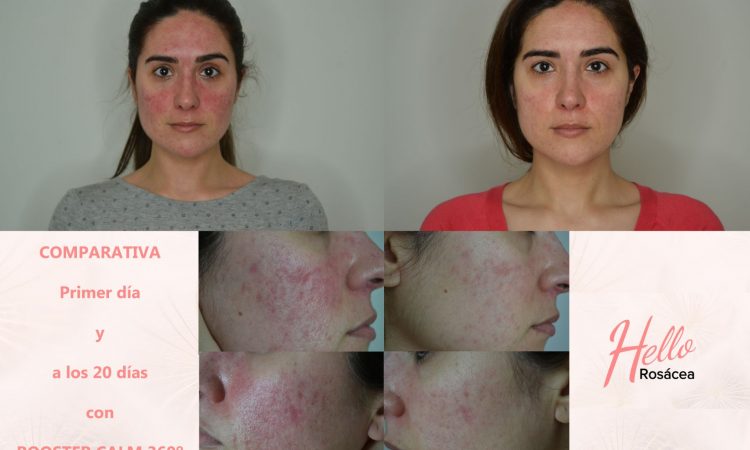¡Vivir con rosácea!
Publicado por ELENA ALARCÓN en

Consejos para tener la rosácea bajo control con @hellorosacea
Últimamente, oímos hablar mucho de la rosácea . Cada vez hay más gente diagnosticada , ya porque se confundía con otra alteración cutánea o porque estamos más expuestos a factores que potencian su aparición . Y lo vamos a conocer de primera mano con Mar Parras de Hellorosacea.
Pero empezamos por el principio . La rosácea es una enfermedad inflamatoria crónica , que se destaca por la aparición de enrojecimiento transitorio recurrente, eritema facial , telangiectasias , pápulas y pústulas en mejillas , nariz , frente , mentón y/o pecho .
La rosácea esta causada por muchos factores , tanto genéticos . cambios inmunológicos y por una alteración en la microbiota de la piel . El ácaro Demodex folliculorum , se encuentra de forma natural en la microbiota de la piel , pero por factores externos se puede producir un incremento de este ácaro generando una reacción inmunológica que lleva a procesos de inflamación típicos de rosácea.
Por ese motivo Ami iyök da mucha importancia a cuidar nuestra microbiota cutánea para evitar patologías cutáneas como la rosácea. Desde Ami iyök , presentamos las ampollas Booster calm como tratamiento para rosácea , con test de eficacia en rosácea para fortalecer la microbiota existente y crear una barrera biocompatible para proteger tu piel.
La pieles con rosácea también se experimenta una pérdida de la funcionalidad de la piel como barrera protectora. Por lo tanto, hay un incremento de la pérdida de agua transdermal , convirtiendo la piel más reseca, sensible y con tendencia a descamars.
Subtipos de rosácea
Existen diferentes tipos de rosácea , las cuales se caracterizan por distintos síntomas y también se pueden confundir con otras patologías cutáneas. Y eso puede hacer que no tratemos de la manera correcta.
Rosácea eritematotelangietásica (RET)
La rosácea RET , se caracteriza por la dilatación de los vasos sanguíneos superficiales ( telangiectasias) y una presencia de enrojecimiento ( eritema) tanto persistentes como transitorios ( flushing) .
Rosácea pápulo-pustular
La rosácea pápulo pustular , se destaca por la presencia de pústulas y pápulas, muy parecido al acné vulgar. Por ese motivo se confunden mucho.
Rosácea fimatosa
En la rosácea fimatosa, aparece una hipertrofia y engrosamiento de la piel, haciéndola irregular. Normalmente se localiza en la zona de la nariz pero también puede aparecer en otras zonas.
Rosácea ocular
La rosácea ocular es una inflamación que causa enrojecimiento , ardor y picor en los ojos.
La rosácea en primera persona con Hellorosacea
Mar Parras , fundadora de la comunidad Hellorosacea , nos explica con naturalidad su experiencia con la rosácea y el tratamiento para la rosácea desde sus inicios hasta ahora. Con consejos y vivencias super útiles para vivir la rosácea más fácil y sin tabús.
También nos comenta su experiencia con las ampollas Booster calm con complemento con el tratamiento para la rosácea y su evolución en su piel.
-
¿Cuándo empezó a aparecer la rosácea?
A los veintisiete años. Un día, al mirarme en el espejo, observé cambios en mi rostro. Comencé a sentir hormigueo, dolor, quemazón, malestar incluso vómitos. Algo me sucedía y no sabía qué era. Tarde varios años hasta saber que era Rosácea.
-
¿La tienes de forma crónica o periódica? ¿Cuándo suelen ser los brotes más fuertes?
La enfermedad de Rosácea es crónica, aunque podemos llegar a contrarrestar sus síntomas. Es decir, no tiene cura pero hay tratamientos para mejorar nuestra calidad de vida.
Los primeros años, se manifestaba en meses puntuales, una o dos veces al año, coincidiendo con los cambios de estación. En cambio, en 2017 ya no cesaba y apenas tenía tiempo de recuperarme cuando comenzaba un nuevo brote, incluso me afectó hasta el ojo y tuve que operarme de un chalazion o orzuelo.
Los brotes más intensos suelen coincidir con épocas de estrés y agobios. Gracias a la rutina de mantenimiento que me pautaron, actualmente los brotes son más leves.
Hoy día, me encuentro en tratamiento por brotes localizados en la zona de la mandíbula por el roce de las mascarillas para protegerme del Covid-19.
-
¿Cómo se siente tu piel? (Si siente dolor , tirantez picor .. etc)
Cada brote es diferente en síntomas y manifestaciones. Los más recurrentes suelen ser dolor, ardor, picor, como una especie de hormigueo por el rostro y tirantez con los cambios bruscos de temperatura.
Mi peor pesadilla se hace real en el verano de 2018. No conseguía controlar el umbral del dolor. Todo me producía reacciones que alteraban aún más la piel.
-
¿Cómo afectó en ti la rosácea psicológicamente?
Al principio lo asimilé bastante bien, pero todo cambió. Poco a poco, me iba creando complejos que hacía que me aislara, eclipsando momento importantes en mi vida. Tanto es así que en mi afán por encajar en esta sociedad y esconder mi rostro, decidí formarme como maquilladora profesional para ocultar mi imagen, y con ello, mis miedos e inseguridades
Analizando todo este tiempo, puedo confesar que en esos años casi pierdo la batalla, dejándome arrastrar por el estrés, la ansiedad y el miedo. Pero un día me levanté y me dije a mi misma “basta, te estás perdiendo cosas que jamás volverán a ocurrir”. Desde entonces, Rosácea y yo caminamos de la mano. He asimilado que un día me dijo “hola” y que desde ese momento sería mi fiel compañera de vida.
-
¿Cuál fue tu primer tratamiento para la rosácea ? ¿Cómo fueron los resultados?
Mi primer tratamiento para la rosácea se basó en antibióticos orales y fotoprotección solar. La verdad es que tardé meses en ver los resultados en la piel y tanto tiempo tomándolos desembocó en una alteración de la flora intestinal.
-
¿Cómo ha sido tu evolución durante este tiempo a nivel de tratamiento?
En estos diez años con Rosácea, he conocido a varios dermatólogos que han ido adaptando los tratamientos para la rosácea a las manifestaciones y síntomas que han ido apareciendo.
La lista es amplia. Me han pautado tratamientos para la rosácea tópicos como metronidazol, ivermectina, ácido azelaico, retinol y tratamientos orales tales como tetreciclina, doxiciclina, minociclina e isotretinoína a bajas dosis.
-
Desde que te diagnosticaron hasta ahora, ¿cree que se conoce más a cerca de la rosácea a nivel dermatológico?
Desde mi experiencia, os puedo decir que la evolución ha sido muy favorable. Hace unos diez años tenía que explicar constantemente qué era esta enfermedad. Incluso mi primer diagnóstico fue erróneo, ya que hay muchas patologías similares con eritemas y en aquellos momentos mis manifestaciones no eran más a nivel de sensaciones, que a nivel visual o estético.
Con los años los tratamientos para la rosácea han evolucionado muchísimo y los pacientes podemos ayudarnos de sus beneficios.
-
¿Te afecta algún alimento? (¿Comida muy caliente o picante?)
Me confieso, tengo intolerancias al gluten, a los lácteos y al huevo. No suelo comer comida picante, pero sí me afecta cuando he tomado algo. Para mí, en brotes, es casi peor el vapor al cocinar, que al ingerir comidas o bebidas muy calientes.
-
¿Cómo afecta el clima en tu piel?
Los cambios de temperatura son mi talón de Aquiles. El vapor y los contrastes bruscos de temperatura, sobre todo el calor, son desencadenantes de flushing o brotes de pápulas y pústulas. El frío me afecta menos, pero mi querido levante gaditano me deja la piel bastante tirante.
-
¿Qué cosméticos utilizas en tu rutina diaria?
Mi rutina actual está pautada por la dermatóloga. Quiero aclarar que ha sido indicada para mis necesidades en este instante y para ello han tenido que hacerme un diagnóstico diferencial.
- Limpiador Hydrating cleanser de Zo Skin Helth.
- Daily power defense de Zo Skin Helth.
- Rozatrol de Zo Skin Helth.
- Booster Calm 360º – WARRIOR I de Ami iyök.
- Toleriane Ultra contorno de ojos de La Roche Posay
- Fotoprotector Fusion Water de Isdin.
Mi rutina antes del tratamiento dermatológico para la rosácea era minimalista: Limpiador Green Shaman, Booster Calm 360º – WARRIOR I, ambos de Ami iyök y fotoprotector Fusion Water de Isdin.
De manera puntual uso mascarillas hidratantes, sobre todo cuando me expongo a cambios bruscos de temperatura. En este caso mis preferidas son Aqua Intense Mascarilla de Rilastil y Kombu Nectar de Ami iyök.
-
¿Cómo crees que se ve la rosácea actualmente?
Poco a poco y con mucho trabajo, vamos consiguiendo cada vez más difusión y normalización de esta patología, pero aún queda mucho por recorrer.
En este último año, se ha hablado más de ella como consecuencia del uso de las mascarillas para protegernos de la pandemia, incluso he percibido un aumento de perfiles en redes sociales dedicados o relacionados con la rosácea.
-
¿Recomendarías Booster Calm a la gente que sufre de rosácea?
Por supuestisimo que sí, para mí es un básico en mi neceser.
Desde que lo conocí en 2019 sigo utilizándolo a diario en mis rutinas, lo único que adapto la cantidad según mis necesidades. La piel ha mejorado, las rojeces han remitido después de un brote y las pigmentaciones de las pápulas y pústulas están desapareciendo. Cómo no voy a estar encantada con sus efectos. Más que un cosmético, lo considero un tratamiento de base para la rosácea para mi enfermedad.
Curiosamente, hablando con mi dermatóloga llegué a la conclusión que mis brotes actuales están situados en las zonas donde no suelo aplicarme la ampolla, gran error por mi parte… el cuello también debemos incluirlo en las rutinas.
-
¿Cuál crees que es el plus o valor añadido de nuestro producto en la fórmula para que te de tan buenos resultados?
No provoca reacciones adversas, es fácil de transportar, dosificar y aplicar, además de su compatibilidad con otros productos cosméticos, e incluso, tratamientos dermatológicos.
Entrando ya en la formulación, y sin tener amplios conocimientos en el tema, creo que un punto fuerte es la combinación del ácido azeláico con aminoácidos y prebióticos para fortalecer la barrera cutánea, tan importante en la rosácea.
En definitiva, lo más importante para mí, es que consigo calmar la piel y equilibrar la función barrera.
-
¿Crees que un buen tratamiento de mantenimiento para la rosácea tiene que ir acompañado de un buen limpiador suave y respetuoso con la microflora o microbiota cutánea?
Según mi experiencia sí. En todos estos años he probado muchos limpiadores que me dejaban la sensación de tirantez en el rostro y la piel estaba mucho más alterada.
-
¿Qué recomendaciones darías a las personas que padecen rosácea?
Cada persona tiene su tiempo y ritmo de adaptación y aceptación. Esta enfermedad afecta bastante a la autoestima, pero hoy día con la ayuda de los expertos podemos controlar sus efectos.
Debemos cuidarnos y no dejarnos llevar por la pereza, la clave está en la constancia y tenacidad con los tratamientos para la rosácea. Y sobre todo tener paciencia, los resultados no vendrán de un día para otro.
En el terreno emocional les aconsejaría que se miren con respeto e interpreten los brotes como puntos de aprendizaje, señales que les recuerdan que deben velar por su salud. Desde hace tiempo, esta es mi filosofía de vida con respecto a la rosácea.
Y sobre todo que “Vivan sin temor y muestren su valor”
Mar Parras
¿ Ya sabes todo a cerca de la rosácea ¿ Te damos algunos consejos para vivir con naturalidad la rosácea
https://www.ami-iyok.com/product/booster-calm-360-warriori-rosacea/


